Symptom of Damage
- Dead heart in 1-3 months old crop, which can be easily pulled out
- Rotten portion of the straw coloured dead heart emits an offensive odour
- Bore holes at the base just above the ground level
Identification of pest
Scientific Name - Chilo infuscatellus snellen
- Egg: Flat – scale like eggs are laid in 3-5 rows on the lower surface of leaves in masses of 4-100. The masses are slightly overlapping like tiles.
It hatches 4-6days.
- Larva: Larva is dirty white with five dark violet longitudinal stripes and dark brown head. Duration 16-30days.
- Pupa: Pupation takes within the tunnel.
Caterpillar before pupating makes a large exit hole in the stem and blocks the opening with silken discs.
- Adult: Pale greyish brown moth with black dots near the coastal margin of the forewings and with white hind wings.
|
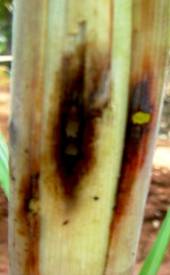 |
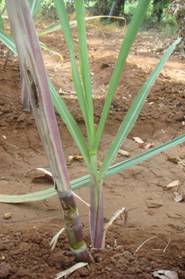 |
| Bore holes |
Side tiller formation |
 |
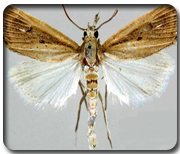 |
| Larva |
Adult |
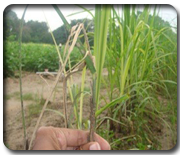 |
 |
Management Strategies
- Use resistant varities like CO 312, CO 421, CO 661, CO 917 and CO 853
- Early planting during December – January escapes the shoot borer incidence.
- Daincha intercropped sugarcane record the lowest early shoot borer incidence.
- Trash mulching along the ridges to a thickness of 10-15 cm 3 days after planting. Remove and destroy dead hearts.
- Ensure adequate moisture to bring down the soil temperature and increase humidity (unfavourable condition for the multiplication of early shoots borer).
- Apply granulosis virus 1.1 x 10 5 IBS / ml (750 diseased larvae / ha) twice on 35 and 50 DAP. Release 125 gravid females of sturmiopsis inferens a tachinid parasite per ac.
|
|
| Top |
| Internode Borer |
 |
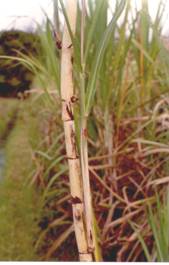 |
Symptom of Damage
-
Internodes constricted and shortened, with a number of boreholes and fresh excreta in the nodal region.
-
Affected tissues reddened.
Nature of Damage
-
Caterpillars attack sugarcane plants after 3 months of planting.
-
They bore into the canes near the nodes
-
Entry holes are plugged with excreta.
-
Entry is generally confined to the first five internodes.
|
| Feeding injury |
Reddening of cane |
 |
|
| |
|
|
|
Identification of pest
Scientific Name - Chilo sacchariphagus indicus (Kapur)
- Egg: Scale – like oval, flat, shiny and waxy white eggs are laid by female moths in batches of 9-11, near the midribs, on leaf sheaths or on stem.
- Larva: White larva with four violet longitudinal stripes and light brown head.
- Pupa: Pupation takes place in semi – dried sheath. Pupal period 7 - 10 days
- Adult: straw coloured with a dark spot on each of the forewings
|
 |
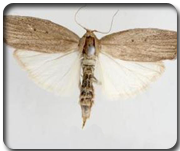 |
| Larva |
Adult |
| |
|
| |
|
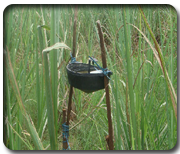 |
 |
Management Strategies
- Use resistant varities like CO 975,COJ 46 and CO 7304
- Select internode borer damage free setts for planting
- Detrashing & burying the trash during the 5th, 7th and 9th month
- Collect and destroy the eggs periodically.
- Detrash the crop on 150th and 210th day of planting. Detrashing dislodge the pupae that remain in the leaf sheath.
- Release egg parasite, Trichogramma chilonis at the rate of 2.5 cc / release / ha. Six release at fortnightly intervals starting from 4th month onwards.
- Setting pheromone traps at spindle levelon 5th month of the crop at the rate of 6 traps per acre in a 15 metre grid. The pheromone septa need to be changed twice at 75 days interval.
|
| |
|
| |
|
| |
|
|
| Top |
| Top Borer |
Symptom of Damage
-
Dead heart arise on after sixth month grown up canes, which cannot be easily pulled.
-
Parallel row of shot holes in the emerging leaves.
-
Bore holes at the top of the shoot and shows bunchy top appearance.
Nature of Damage
-
Caterpillars are mainly found in the apical portion of the canes, boring through the growing point and down the upper joints until it reaches the sappy portion of the stem, there it feeds on the tissues and destroys the cane.
-
They also bore into the unfolded leaves preferably into the midrib, mining its way to the base.
|
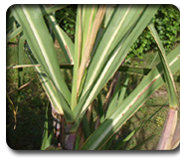 |
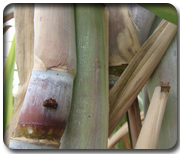 |
 |
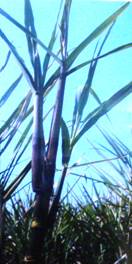 |
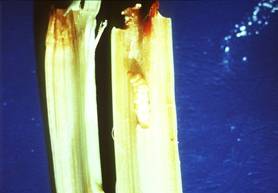 |
 |
Identification of pest
Scientific Name - Scirpophaa excerptalis (Fb.)
- Egg: Eggs are laid on the lower surface of top leaves in clusters particularly near midribs. The clusters are covered with buff coloured hairs. : 10-80 eggs per egg mass
- Larva: Smooth, white or cream coloured with a red coloured mid – dorsal line and yellow head.
- Pupa: Pupation takes place within the larval tunnel in a chamber with an exit hole Constructed by the caterpillar. Pupal period 6 - 21 days
- Adult: White Coloured moth (with a buff Coloured anal tuft in the abdominal tip of female)
|
| Larva |
Adult |
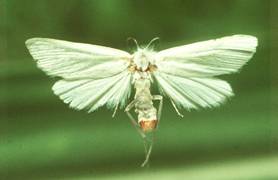 |
|
| Adult |
|
Management Strategies
- Use resistant variety CO 419, CO 745 and CO 6516 and tolerant varieties Co 859, Co 1158 and Co 7224.
- Collect and destroy the egg masses.
- Release Ichneumonid parasitized Gambroides (Isotima) javensis @ 100 pairs / ha as prepupal parasitoid.
|
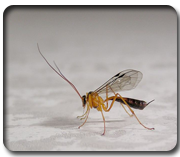 |
|
|
| Top |
| Termites |
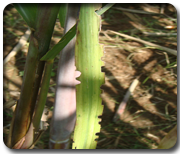 |
 |
Symptom of Damage
- Poor germination of setts (after planting)
- Characteristic semi – circular feeding marks on the margin of the leaves in the standing crop.
- Causes yellowing and drying of outer leaves first followed by the inner leaves Entire shoot dries up and can be pulled out.
- Setts hollow inside and may be filled with soil.
- Cane collapses if disturbed; rind filled with mud.
|
Identification of pest
Scientific Name - Odontotermes obesus Rhamb
-
Eggs: Dull, kidney shaped and hatches in 30-90 days
-
Nymphs: Moult 8-9 times and are full grown in 6-12 months
- Adult: Creamy coloured tiny insects resembling ants with dark coloured head
|
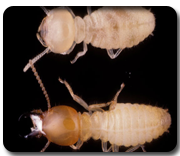 |
|
 |
|
Management Strategies
- Flood irrigation at the time of planting.
- Locate and destroy the termite colony.
- Collect and destroy the termite affected setts from the field.
|
|
| Top |
| Sugarcane Wooly Aphid |
|
Symptom of Damage
- Adults and nymphs desap leaves by piercing styles through stomata. Whitish patches
- Coalesce to turn yellowish and drying from the tip along margins. Leaves become brittle and dries completely.
- Heavy secretion of honey dew
- Development of sooty mould.
- Deposition of wooly matter on ground / soil distinctly visible.
|
 |
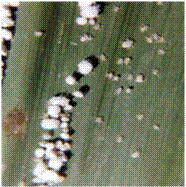 |
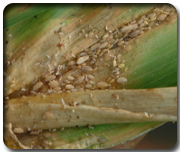 |
|
Identification of pest
Scientific Name - Ceratovacuna lanigera
- Nymph - Third and fourth instar nymphs covered with white wooly secretion
- Adult - Apterous adults covered with white wooly secretion
- Ceratovacuna lanigera - Light green colour
- C. graminum - Light yellow in colour. Winged adult is black in colour
|
Management Strategies
- Paired row system of planting.
- Avoid excessive use of nitrogenous fertilizers.
- Use of organic fertilizers.
- Rapping of canes all along the rows.
- Infested tops should not be transported.
- Infested canes should not be used as seed for planting.
- Encourage local predators like Diapha aphidivora Meyrick – Pyralidae Ishchiodon scutellaris, Episyrphus baleatus – Syrphidae, Chrysopa spp. – Chryospidae, Schymnus sp., Cheilomeness sexmaculata, Coccinella septempunctata, Synnonycha grandis, Brumus sp. and Dideopsis aegrota – Coccinellidae
- Pathogens like Cladosporium oxysporum, Metarhizium anisopliae, Verticillium lecanii and Beauveria bassiana
|
|
|
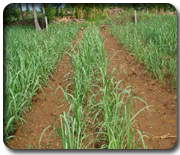 |
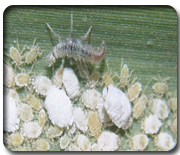 |
| |
|
|
| Top |
| Whiteflies |
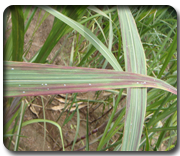 |
 |
Symptom of Damage
- Yellowing of leaves
- Leaf turns pinkish or purple and later gradually dry.
- Infested leaves look white and black dots.
|
Identification of pest
Scientific Name - Aleurolobus barodensis
- Egg: Females lay eggs in a line near the midrib or any where on the lower surface of the leaves. Eggs are yellowish with a small curved stalk. Colour changes to black about two hours after the eggs are laid.
- Nymph & Pupa: Neonate nymphs are pale yellow in colour, flat and oval in shape, later turn shiny black. Its body is surrounded by fringes of wax.The fourth instar being the pupal stage, is flat, oval, grayish in colour and slightly bigger than the nymph. There is a ‘T’ shaped white marking on the thorax, which splits at the time of adult emergence.
- Adult: Pale yellow body with hyaline wings dusted with waxy bloom, exhibit brisk fluttering movements.
|
 |
|
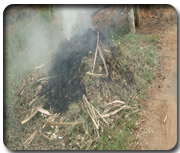 |
|
Management Strategies
- Avoid indiscriminate use of insecticides for control of other pests such as pyrilla, black bug, wooly aphids
- Detrashing the puparia bearing leaves and immediately disposing by burning or burying to prevent emergence of adult white flies
|
| |
|
| Top |
| Mealybug |
Symptom of Damage
- Pinkish oval insects beneath leaf sheath on the nodes, with whitish mealy coating, main cane stunned also attack roots. Sooty mould develops on the honey dew giving blackish appearance on canes.
|
 |
|
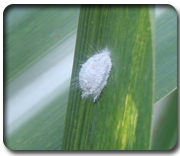 |
 |
Identification of pest
Scientific Name - Saccharicoccus sacchari
- Eggs: Eggs are retained in the female reproductive organs untils almost fully mature. Incubation period is short. The females may bring forth hundreds of young ones parthenogenetically. Egg is yellowish, smooth, cylindrical and rounded at both ends.
- Nymph: Newly emerged nymphs are quite active with a pinkish transparent body.
- Adult: White with mealy coating, sessile.
|
Management Strategies
- Use resistant varieties like CO 439, CO 443, CO 720, CO 730 and CO 7704
- Drain excess water from the field.
- Detrash the crop on 150 and 210 DAP
|
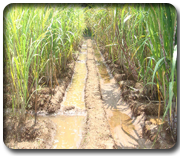 |
|
| |
| |
| |
|
| Top |
| Scale Insects |
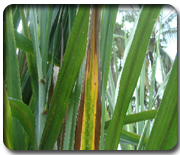 |
|
Symptom of Damage
- The leaves of infested canes show signs of tip drying and unhealthy pale green colour and with continued infestation these turn yellow.
- Desapping leads to non-opening of leaves also, which also turn yellow and finally dry up.
- Nodal region is more infested than internodal region.
- Infested crop losses its vigour, canes shrivel, growth is stunted and the internodal length is reduced drastically.
- Ultimately cane dries up. Such canes when slit open appear brownish red.
|
| |
| |
| |
|
Identification of pest
Scientific Name - Melanaspis glomerata (Green)
- Nymph: Females multiply ovo-viviparously. The nymphs that hatch out from the eggs within the female’s body come out through the genital aperture. They are called ‘crawlers’. They settle after selecting suitable site for feeding.
- Adult: Greyish black or brown circular scales, they cover the nodal region forming a thick encrustation.
|
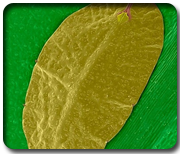 |
|
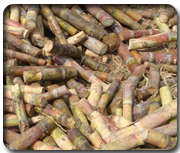 |
|
Management Strategies
- Use resistant varieties like CO 439, CO 443, CO 453, CO 671, CO 691 and CO 692
- Select and plant the scale insect free setts.
- Keep the fields and bunds free from weeds.
- Avoid water stagnation in the field for the longer period.
- Avoid repeated ratoons.
- Detrash the crop at 150th and 210th day of planting.
- Release Chilocoris nigritus (or) Pharascymnus horni.
|
|
| Top |